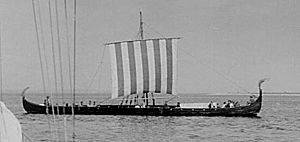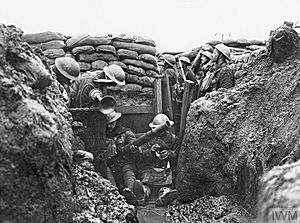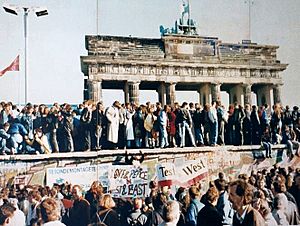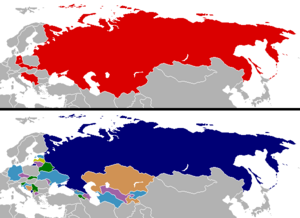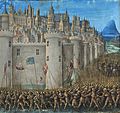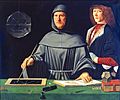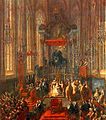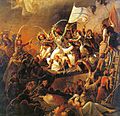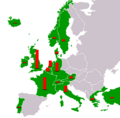History of Europe facts for kids
The history of Europe tells the story of people living in Europe from ancient times until today.
Long ago, classical antiquity began with the rise of Greek city-states. Later, the mighty Roman Empire controlled the entire Mediterranean Sea. The fall of the Roman Empire in 476 AD marks the start of the Middle Ages.
Around the 14th century, a time called the Renaissance brought new ideas in science and religion. At the same time, the Protestant Reformation led to new churches, especially in Germany, Scandinavia, and England.
After 1800, the Industrial Revolution made Britain and Western Europe very wealthy. European powers created colonies in the Americas, Africa, and parts of Asia.
In the 20th century, World War I and World War II caused many deaths. The Cold War then shaped European politics from 1947 to 1989.
Countries began to unite into the European Union after 1950. Today, most countries west of Russia are part of the NATO military alliance, along with the United States and Canada.
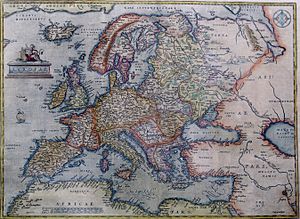
Contents
Europe's Early Civilizations
Some of Europe's oldest known civilizations were the Minoans and Mycenaeans. They thrived during the Bronze Age but suddenly collapsed around 1200 BC.
The period of classical antiquity started with the Greek city-states. After stopping the Persian army in the Greco-Persian Wars, Greek influence grew. Alexander the Great spread Greek culture across Asia, Africa, and parts of Europe.
The Roman Empire then took control of the whole Mediterranean Sea region. By 300 AD, the Roman Empire split into Western and Eastern parts. In the 4th and 5th centuries, Germanic peoples from Northern Europe grew stronger. Their attacks led to the fall of the Western Roman Empire. The year 476 AD is often seen as the end of the classical period and the start of the Middle Ages.
The Middle Ages in Europe
In Western Europe, Germanic groups formed their own kingdoms. The Franks became very powerful, especially under Charlemagne around 800 AD. His empire later split into parts. West Francia became France, and East Francia became the Holy Roman Empire. This empire was a early version of modern Germany and Italy.
The Viking Age (late 700s to mid-1000s) saw people from Scandinavia travel widely. The Normans, who were Vikings settled in France, greatly influenced many parts of Europe. This included the Norman conquest of England and their rule in Southern Italy and Sicily. The Rus' people founded Kievan Rus', which grew into Russia.
After 1000 AD, the Crusades began. These were religious military trips meant to take back the Holy Land for Christians. The Crusaders opened new trade routes. This helped cities like Genoa and Venice become major trading centers. The Reconquista was a similar effort to reclaim Spain and Portugal from Muslim rule.
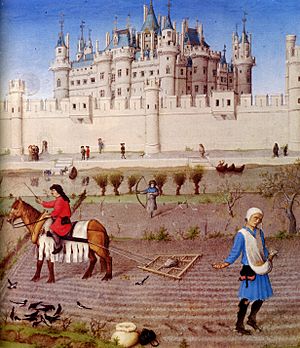
Eastern Europe in the High Middle Ages was shaped by the rise and fall of the Mongol Empire. Led by Genghis Khan, the Mongols created a huge empire from China to the Black and Baltic Seas. As Mongol power faded, the Grand Duchy of Moscow became the strongest Russian state. It grew into the Tsardom of Russia by 1547.
The Late Middle Ages were a time of big changes in Europe. The Black Death, a terrible sickness, killed about a third of Europe's population. Wars and power struggles also kept many states fighting. In Scandinavia, the Kalmar Union was important. England fought Scotland in the Wars of Scottish Independence and France in the Hundred Years' War.
In Central Europe, the Polish-Lithuanian Commonwealth became a large empire. The Holy Roman Empire was ruled for centuries by the House of Habsburg. Russia kept expanding south and east into former Mongol lands. In the Balkans, the Ottoman Empire took over Byzantine lands. The Fall of Constantinople in 1453 marked the end of the Middle Ages for historians.
New Ideas and Discoveries
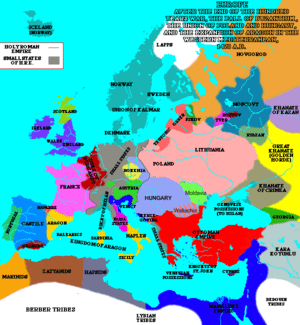
Starting in Florence in the 14th century, the Renaissance brought new knowledge and challenged old beliefs. People rediscovered ideas from ancient Greece and Rome, which greatly inspired thinkers. At the same time, the Protestant Reformation began with Martin Luther in Germany. He questioned the Pope's power. Henry VIII took control of the English Church.
Religious wars were fought across Europe. The Reconquista ended Muslim rule in Spain and Portugal. By the 1490s, a period called the Age of Discovery began. Explorers sailed across oceans, creating direct links with Africa, the Americas, and Asia. Religious wars in Europe continued until the Peace of Westphalia in 1648.
Spain was the leading power in Europe until the Treaty of the Pyrenees. This treaty ended a war between Spain and France. Many major wars and political changes happened in Europe and around the world between 1610 and 1700.
The Industrial Revolution and French Revolution
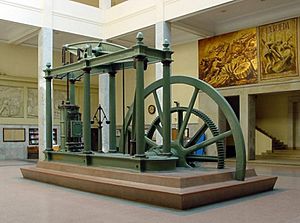
The Industrial Revolution started in Great Britain. It was based on coal, steam power, and textile factories. Political changes in Europe were also driven by the French Revolution. Its motto was "liberty, equality, fraternity." Napoleon Bonaparte took charge, made many changes in France, and reshaped Western Europe. However, his rise also led to strong feelings of nationalism and resistance. He was defeated in 1814–15, and the old royal families returned to power.
Between 1815 and 1871, many parts of Europe (except Britain) saw attempts at revolution. All of them failed. As more people worked in factories in Western Europe, socialism and trade unions grew. The last forms of serfdom were ended in Russia in 1861. Greece and other Balkan nations slowly gained independence from the Ottoman Empire, starting in the 1820s. Italy became a united country in 1860.
After the Franco-Prussian War of 1870–71, Otto von Bismarck united the German states into an empire. This German Empire was very powerful until 1914. Most European countries rushed to gain colonies in Africa and Asia during the the Age of Empire. Britain and France built the largest empires. Diplomats worked to prevent major wars in Europe, except for the Crimean War in the 1850s.
World Wars and the Cold War
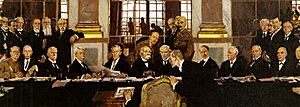
The First World War began in 1914. It was caused by rising nationalism in Southeastern Europe and the major powers taking sides. In 1917, the October Revolution turned the Russian Empire into the world's first communist state, the Soviet Union. The Allies, led by Britain and France, defeated the Central Powers (Germany and Austria-Hungary) in 1918.
At the Paris Peace Conference, the winners set harsh terms for Germany in treaties like the Treaty of Versailles. The war caused immense death and destruction. Germany lost its colonies and provinces, had to pay large amounts of money, and felt humiliated. The 1920s were good until the Great Depression hit in 1929. This led to the collapse of democracy in many European countries.
The Nazi regime under Adolf Hitler came to power in Germany in 1933. Hitler rearmed Germany and, with Mussolini's Italy, tried to expand their power. This eventually led to the Second World War. Most of the fighting happened on the Eastern Front. The war ended with the defeat of the Axis powers. The USSR controlled Eastern Europe, and the United States influenced Western Europe.
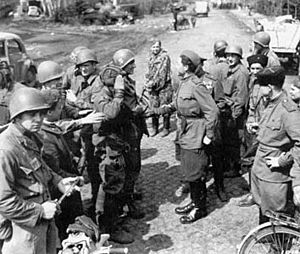
The Iron Curtain now divided the communist East (controlled by Moscow) from the capitalist West. The United States launched the Marshall Plan (1948–51) and NATO (1949). These helped rebuild Western European economies, which were thriving by the 1950s. France and West Germany led the creation of the European Economic Community, which later became the European Union (EU).
Religion became less important in most of Europe. However, churches remained strong where they symbolized resistance against governments, like in Poland. The Revolutions of 1989 ended Soviet control and communism in Eastern Europe. Germany was reunited, and the EU and NATO expanded eastward. The EU faced challenges after the Great Recession began in 2008.
Europe's Recent History
After the Cold War ended, the European Economic Community worked for closer ties. It also started to include neutral and former communist countries. In 1993, the Treaty of Maastricht created the European Union. This agreement led to more political cooperation. Neutral countries like Austria, Finland, and Sweden joined the EU. Other countries joined the EU's economic market through the European Economic Area. These countries also joined the Schengen Agreement, which removed border checks between member states.
The Maastricht Treaty also created a single currency for most EU members. The euro was introduced in 1999 and replaced national currencies in participating countries by 2002. The United Kingdom was a notable exception. It did not join the euro or the Schengen Agreement.
The EU did not take part in the Yugoslav Wars. It was also divided on whether to support the United States in the 2003–2011 Iraq War. NATO was involved in the war in Afghanistan, but with less involvement than the United States.
In 2004, the EU welcomed 10 new members. These included Estonia, Latvia, and Lithuania (former Soviet republics). Also, the Czech Republic, Hungary, Poland, Slovakia, and Slovenia (former communist countries) joined. Malta and the divided island of Cyprus also became members. Bulgaria and Romania followed in 2007. Russia saw these expansions as breaking a promise not to expand NATO "one inch to the east" in 1990. Russia had disputes over gas supplies with Belarus and Ukraine, which affected Europe's gas supply. Russia also fought a small war with Georgia in 2008.
With support from the United States and some European countries, Kosovo declared independence from Serbia on February 17, 2008.
Public opinion in the EU turned against further expansion. This was partly because some felt the EU was expanding too quickly. The European Constitution was rejected in France and the Netherlands. Later, a new version (the Treaty of Lisbon) was rejected in Ireland, though a second vote passed in 2009.
The financial crisis of 2007–08 affected Europe. Governments responded with austerity measures. Smaller EU nations, especially Greece, struggled with their debts. This led to social unrest and financial problems. In May 2010, Germany agreed to loan Greece money, but only if Greece followed strict spending cuts. This was part of the European sovereign-debt crisis.
Starting in 2014, Ukraine experienced unrest and revolution. Two regions, Donetsk and Lugansk, tried to join Russia. On March 16, a vote in Crimea led to its separation and annexation by Russia. This was largely not recognized by other countries.
In June 2016, the United Kingdom held a vote on leaving the European Union. 52% of voters chose to leave. This led to the complex Brexit process. The UK officially left the EU on January 31, 2020. This caused political and economic changes for both the UK and the remaining EU countries.
Timeline of Key Events
- 700 BC: Homer writes The Iliad, an early European story.
- 440 BC: Herodotus writes Histories, defending Athenian freedom.
- 323 BC: Alexander the Great dies, and his empire splits.
- 44 BC: Julius Caesar is killed. The Roman Republic faces its end.
- 27 BC: The Roman Empire begins under Augustus.
AD
- 45–55 (approx.): First Christian groups form in Greece and Rome.
- 293: Diocletian divides the Roman Empire into four parts.
- 330: Constantine makes Constantinople his new capital.
- 395: After Theodosius I dies, the Roman Empire permanently splits into Western and Eastern parts.
- 476: Odoacer removes the last Western Roman emperor. This is seen as the end of the Western Roman Empire.
- 527: Justinian I becomes emperor of Byzantium. He orders the creation of Corpus Juris Civilis, a major law collection.
- 597: Christianization of Anglo-Saxon England begins.
- 600: Saint Columbanus uses the term "Europe" in a letter.
- 681: Khan Asparukh creates Bulgaria.
- 718: Tervel of Bulgaria helps the Byzantine Empire stop an Arab invasion of Europe.
- 732: At the Battle of Tours, the Franks stop the Arabs from advancing into Europe.
- 800: Charlemagne is crowned Holy Roman Emperor.
- 813: Priests are told to preach in local languages.
- 843: Treaty of Verdun divides Charlemagne's empire.
- 863: Saints Cyril and Methodius begin Christian missions among Slavic peoples.
- 864: Boris I of Bulgaria converts Bulgaria to Eastern Orthodox Christianity.
- 872: Unification of Norway.
- 886: The Cyrillic alphabet becomes official in Bulgaria.
- 895: Hungarian people settle in the Carpathian Basin.
- 917: Bulgaria defeats the Byzantine Empire. Simeon I of Bulgaria is proclaimed emperor.
- 962: Otto I is crowned "Emperor," starting the Holy Roman Empire.
- 988: Kievan Rus' adopts Christianity.
- 1054: The East–West Schism divides the Christian church.
- 1066: William the Conqueror successfully invades England.
- 1095: Pope Urban II calls for the First Crusade.
- 12th century: More texts are written. The Renaissance of the 12th century occurs.
- 1128: Formation of Portuguese sovereignty.
- 1250: Death of Frederick II, Holy Roman Emperor. German emperors lose power in Italy.
- 1303: The period of the Crusades ends.
- 1309–1378: The Popes live in Avignon, France.
- 1315–1317: A great famine hits Northern Europe.
- 1341: Petrarch, the "Father of Humanism", becomes the first poet laureate since ancient times.
- 1337–1453: The Hundred Years' War between England and France.
- 1348–1351: The Black Death kills about one-third of Europe's population.
- 1439: Johannes Gutenberg invents the printing press, starting the Printing Revolution.
- 1453: Constantinople falls to the Ottoman Turks.
- 1492: The Reconquista ends in Spain and Portugal. Christopher Columbus lands in the New World.
- 1497: Vasco da Gama sails to India, starting direct trade with Asia.
- 1498: Leonardo da Vinci paints The Last Supper.
- 1508: Maximilian I is the first "elected Emperor of the Romans."
- 1517: Martin Luther posts his 95 theses, starting the Protestant Reformation.
- 1519: Ferdinand Magellan and Juan Sebastián Elcano begin the first trip around the world.
- 1519: Hernán Cortés begins the conquest of Mexico for Spain.
- 1532: Francisco Pizarro begins the conquest of Peru for Spain.
- 1543: Nicolaus Copernicus publishes his book on Earth revolving around the Sun.
- 1547: The Grand Duchy of Moscow becomes the Tsardom of Russia.
- 1582: The Gregorian calendar is introduced.
- 1610: Galileo Galilei discovers Jupiter's moons with his telescope.
- 1618: The Thirty Years' War devastates Central Europe.
- 1648: The Peace of Westphalia ends the Thirty Years' War. It introduces the idea of independent nation-states.
- 1687: Isaac Newton publishes Principia Mathematica, influencing the Age of Enlightenment.
- 1699: The Treaty of Karlowitz ends Ottoman control of Central Europe.
- 1700: The War of the Spanish Succession and the Great Northern War begin.
- 18th century: The Age of Enlightenment brings new ideas across Europe.
- 1707: The Kingdom of Great Britain is formed by England and Scotland.
- 1712: Thomas Newcomen invents the first practical steam engine.
- 1721: Foundation of the Russian Empire.
- 1775: James Watt invents a more efficient steam engine.
- 1789: The French Revolution begins, ending absolute monarchy in France.
- 1792–1802: French Revolutionary Wars.
- 1799: Napoleon becomes dictator of France.
- 1803–1815: Napoleonic Wars end with Napoleon's defeat.
- 1806: Napoleon abolishes the Holy Roman Empire.
- 1814–15: Congress of Vienna redraws Europe's map.
- 1825: George Stephenson opens the first passenger steam train railway.
- 1836: Louis Daguerre invents the first practical photographic method.
- 1838: The first steamship for regular transatlantic crossings begins service.
- 1848: Revolutions of 1848 occur. The Communist Manifesto is published.
- 1852: The Crimean War begins.
- 1859: Charles Darwin publishes On the Origin of Species.
- 1861: Unification of Italy occurs.
- 1866: First successful transatlantic telegraph cable is completed.
- 1860s: Russia frees its serfs. Karl Marx writes Das Kapital.
- 1870: Franco-Prussian War and the fall of the Second French Empire.
- 1871: Unification of Germany under Otto von Bismarck.
- 1873: The Panic of 1873 begins the Long Depression.
- 1885: Karl Benz invents the world's first automobile.
- 1885: First permanent electrical tram system in Europe (Sarajevo).
- 1895: Auguste and Louis Lumière begin showing projected films.
- 1902: Guglielmo Marconi sends the first transatlantic radio transmission.
- 1914: Archduke Franz Ferdinand of Austria is killed; World War I begins.
- 1917: Vladimir Lenin and the Bolsheviks take power in the Russian Revolution.
- 1918: World War I ends. Ten million soldiers die. Empires collapse.
- 1918: Worldwide Spanish flu epidemic kills millions.
- 1919: Treaty of Versailles imposes harsh terms on Germany.
- 1920: League of Nations begins operations.
- 1921–22: Ireland is divided.
- 1922: Benito Mussolini and the Fascists take power in Italy.
- 1929: The Great Depression begins.
- 1933: Adolf Hitler and the Nazis take power in Germany.
- 1935: Italy conquers Ethiopia.
- 1936: The Spanish Civil War begins.
- 1938: Germany increases persecution of Jews with Kristallnacht.
- 1938: Britain and France try to appease Germany; Munich agreement splits Czechoslovakia.
- 1939: Hitler and Joseph Stalin agree to divide Eastern Europe.
- 1939: Germany invades Poland, starting World War II.
- 1940: Great Britain, under Winston Churchill, holds out against the Nazis.
- 1941: U.S. begins aid to Britain, France, and the USSR.
- 1941: Germany invades the Soviet Union.
- 1942: Nazi Germany begins the Holocaust, murdering 6 million Jews.
- 1943: Soviet forces begin retaking Nazi-occupied territory.
- 1944: Allied forces invade Nazi-occupied France at Normandy.
- 1945: Hitler dies. World War II ends in Europe.
- 1945: United Nations is formed.
- 1947: The British Empire begins to dismantle.
- 1947: The Cold War begins, dividing Europe.
- 1948–51: U.S. provides aid to rebuild Western Europe through the Marshall Plan.
- 1949: The NATO alliance is established.
- 1955: USSR creates the Warsaw Pact.
- 1950: The Schuman Declaration begins European integration.
- 1954: The French Empire begins to dismantle.
- 1956: Suez Crisis signals the end of the British Empire's power.
- 1956: Hungarian Uprising is defeated by Soviet forces.
- 1957: Treaties of Rome establish the European Economic Community.
- 1968: Protests in France.
- 1968: The Prague Spring is defeated by Warsaw Pact forces.
- 1980: The Solidarność movement begins in Poland.
- 1985: Mikhail Gorbachev begins reforms in the Soviet Union.
- 1986: Chernobyl disaster occurs.
- 1989: Communism is overthrown in Eastern Europe. The Berlin Wall falls.
- 1990: Germany is reunited.
- 1991: Breakup of Yugoslavia begins.
- 1991: The Soviet Union dissolves.
- 1993: Treaty of Maastricht establishes the European Union.
- 2002: End of European colonial empires with East Timor's independence.
- 2004: Slovenia, Hungary, Czech Republic, Slovakia, Poland, Lithuania, Latvia, Estonia, Cyprus, and Malta join the EU.
- 2007: Romania and Bulgaria join the EU.
- 2008: The Great Recession begins.
- 2013: Croatia joins the European Union.
- 2014: Revolution in Ukraine and tensions with Russia.
- 2015: European migrant crisis starts.
- 2020: The United Kingdom leaves the European Union.
- 2020: COVID-19 pandemic hits Europe.
Related pages
Images for kids
-
The Roman Republic and its neighbors in 58 BC.
-
Cicero addresses the Roman Senate to denounce Catiline's conspiracy.
-
The Roman Empire at its greatest extent in 117 AD, under Trajan.
-
Europe in 1097, as the First Crusade to the Holy Land commences.
-
The Siege of Antioch, from a medieval miniature painting.
-
"Christianization of Lithuania in 1387", by Jan Matejko.
-
Portrait of Luca Pacioli, the founder of accounting.
-
Europa regina, 1570 print by Sebastian Münster.
-
Alberico Gentili, the Father of international law.
-
The storming of the Bastille in the French Revolution of 1789.
-
Cheering the Revolutions of 1848 in Berlin.
-
The Greek War of Independence began in 1821.
-
Mikhail Bakunin speaking at the Basel Congress in 1869.
-
Paris Commune, 1871.
-
Giuseppe Garibaldi's redshirts during the Battle of Calatafimi.
-
Otto von Bismarck, Chancellor of Germany.
-
The Berlin Conference (1884) headed by Otto von Bismarck.
-
FAI militia during the Spanish Social Revolution.
-
The fight against German Nazis during the Warsaw Uprising in 1944.
See also
 In Spanish: Historia de Europa para niños
In Spanish: Historia de Europa para niños


